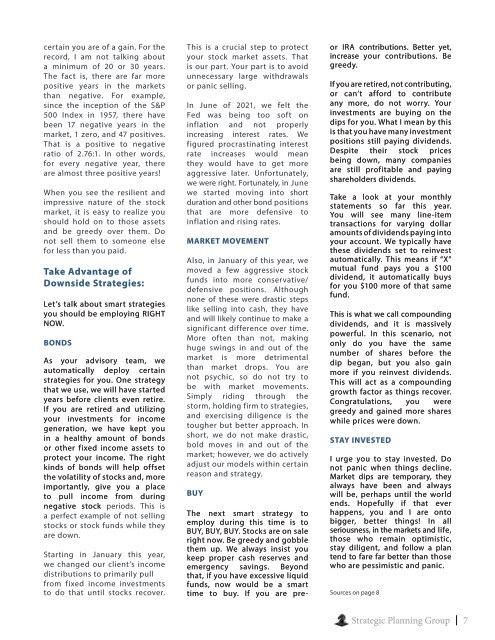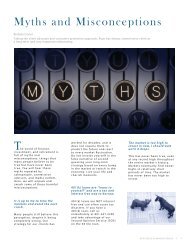Spring 2022 Newsletter
In this Spring 2022 Newsletter, learn some valueable information to help navigate through an era of inflation and other market worries.
In this Spring 2022 Newsletter, learn some valueable information to help navigate through an era of inflation and other market worries.
You also want an ePaper? Increase the reach of your titles
YUMPU automatically turns print PDFs into web optimized ePapers that Google loves.
certain you are of a gain. For the<br />
record, I am not talking about<br />
a minimum of 20 or 30 years.<br />
The fact is, there are far more<br />
positive years in the markets<br />
than negative. For example,<br />
since the inception of the S&P<br />
500 Index in 1957, there have<br />
been 17 negative years in the<br />
market, 1 zero, and 47 positives.<br />
That is a positive to negative<br />
ratio of 2.76:1. In other words,<br />
for every negative year, there<br />
are almost three positive years!<br />
When you see the resilient and<br />
impressive nature of the stock<br />
market, it is easy to realize you<br />
should hold on to those assets<br />
and be greedy over them. Do<br />
not sell them to someone else<br />
for less than you paid.<br />
Take Advantage of<br />
Downside Strategies:<br />
Let’s talk about smart strategies<br />
you should be employing RIGHT<br />
NOW.<br />
BONDS<br />
As your advisory team, we<br />
automatically deploy certain<br />
strategies for you. One strategy<br />
that we use, we will have started<br />
years before clients even retire.<br />
If you are retired and utilizing<br />
your investments for income<br />
generation, we have kept you<br />
in a healthy amount of bonds<br />
or other fixed income assets to<br />
protect your income. The right<br />
kinds of bonds will help offset<br />
the volatility of stocks and, more<br />
importantly, give you a place<br />
to pull income from during<br />
negative stock periods. This is<br />
a perfect example of not selling<br />
stocks or stock funds while they<br />
are down.<br />
Starting in January this year,<br />
we changed our client’s income<br />
distributions to primarily pull<br />
from fixed income investments<br />
to do that until stocks recover.<br />
This is a crucial step to protect<br />
your stock market assets. That<br />
is our part. Your part is to avoid<br />
unnecessary large withdrawals<br />
or panic selling.<br />
In June of 2021, we felt the<br />
Fed was being too soft on<br />
inflation and not properly<br />
increasing interest rates. We<br />
figured procrastinating interest<br />
rate increases would mean<br />
they would have to get more<br />
aggressive later. Unfortunately,<br />
we were right. Fortunately, in June<br />
we started moving into short<br />
duration and other bond positions<br />
that are more defensive to<br />
inflation and rising rates.<br />
MARKET MOVEMENT<br />
Also, in January of this year, we<br />
moved a few aggressive stock<br />
funds into more conservative/<br />
defensive positions. Although<br />
none of these were drastic steps<br />
like selling into cash, they have<br />
and will likely continue to make a<br />
significant difference over time.<br />
More often than not, making<br />
huge swings in and out of the<br />
market is more detrimental<br />
than market drops. You are<br />
not psychic, so do not try to<br />
be with market movements.<br />
Simply riding through the<br />
storm, holding firm to strategies,<br />
and exercising diligence is the<br />
tougher but better approach. In<br />
short, we do not make drastic,<br />
bold moves in and out of the<br />
market; however, we do actively<br />
adjust our models within certain<br />
reason and strategy.<br />
BUY<br />
The next smart strategy to<br />
employ during this time is to<br />
BUY, BUY, BUY. Stocks are on sale<br />
right now. Be greedy and gobble<br />
them up. We always insist you<br />
keep proper cash reserves and<br />
emergency savings. Beyond<br />
that, if you have excessive liquid<br />
funds, now would be a smart<br />
time to buy. If you are preor<br />
IRA contributions. Better yet,<br />
increase your contributions. Be<br />
greedy.<br />
If you are retired, not contributing,<br />
or can’t afford to contribute<br />
any more, do not worry. Your<br />
investments are buying on the<br />
dips for you. What I mean by this<br />
is that you have many investment<br />
positions still paying dividends.<br />
Despite their stock prices<br />
being down, many companies<br />
are still profitable and paying<br />
shareholders dividends.<br />
Take a look at your monthly<br />
statements so far this year.<br />
You will see many line-item<br />
transactions for varying dollar<br />
amounts of dividends paying into<br />
your account. We typically have<br />
these dividends set to reinvest<br />
automatically. This means if “X”<br />
mutual fund pays you a $100<br />
dividend, it automatically buys<br />
for you $100 more of that same<br />
fund.<br />
This is what we call compounding<br />
dividends, and it is massively<br />
powerful. In this scenario, not<br />
only do you have the same<br />
number of shares before the<br />
dip began, but you also gain<br />
more if you reinvest dividends.<br />
This will act as a compounding<br />
growth factor as things recover.<br />
Congratulations, you were<br />
greedy and gained more shares<br />
while prices were down.<br />
STAY INVESTED<br />
I urge you to stay invested. Do<br />
not panic when things decline.<br />
Market dips are temporary, they<br />
always have been and always<br />
will be, perhaps until the world<br />
ends. Hopefully if that ever<br />
happens, you and I are onto<br />
bigger, better things! In all<br />
seriousness, in the markets and life,<br />
those who remain optimistic,<br />
stay diligent, and follow a plan<br />
tend to fare far better than those<br />
who are pessimistic and panic.<br />
Sources on page 8<br />
Strategic Planning Group 7
















